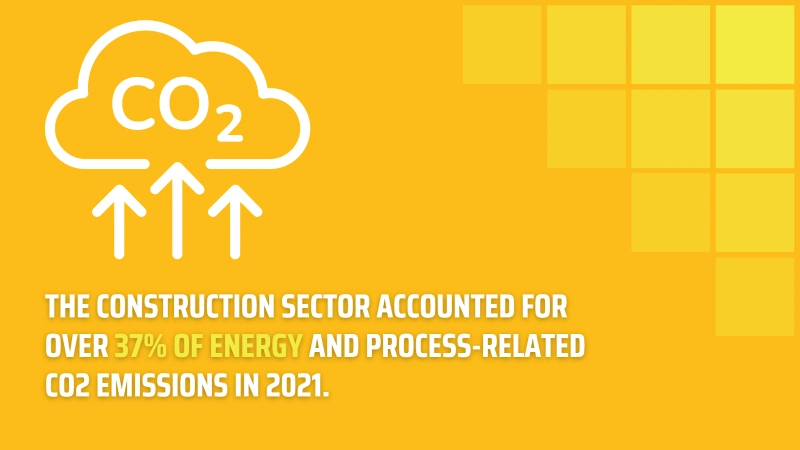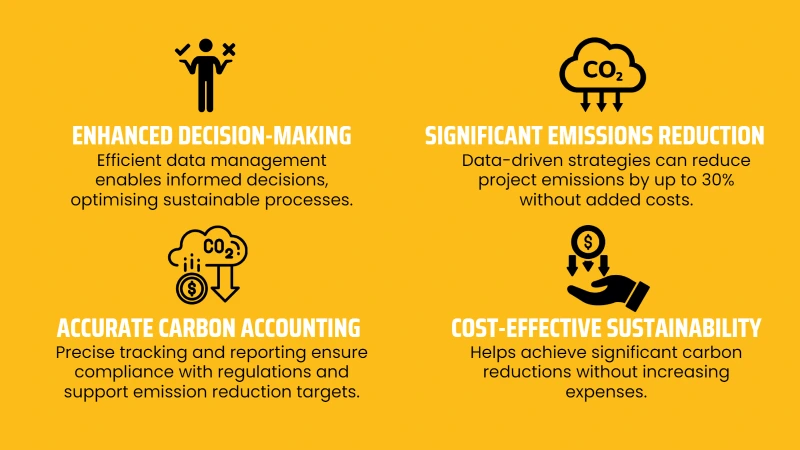What is Carbon Accounting in Construction?
Carbon accounting and reporting in construction involves measuring and reporting the carbon footprint of construction activities, ensuring accuracy and compliance with environmental standards.
It is a continuous process of measuring and managing the greenhouse gas (GHG) emissions associated with construction activities. This involves quantifying both direct and indirect emissions throughout the lifecycle of construction projects, including the material production, transportation, construction activities, and the operational phase of the built environment.
The construction industry, a significant contributor to global carbon emissions, is under increasing pressure to reduce its environmental impact. This blog delves deeper into the construction industry’s specific challenges and opportunities in carbon accounting, along with emerging trends and adaptation strategies.
The Construction Industry’s Carbon Footprint
In the release of climate talks in Egypt, COP27, the 2022 Global Status Report for Buildings and Construction stated that the construction sector accounted for over 34% energy demand and around 37% of energy and process-related CO2 emissions in 2021.

The construction industry’s carbon footprint is very extensive, encompassing:
- Embodied carbon: Emissions from the extraction, processing, and transportation of building materials.
- Operational carbon: Emissions from the building’s energy consumption during its lifecycle.
- Indirect emissions: Emissions from the construction process, such as transportation of workers and equipment.
Addressing these emissions requires a holistic approach to carbon accounting.
What are the Challenges in Construction Carbon Accounting?
- Data availability: Accurate data on material sourcing, energy consumption, and waste generation can be challenging to obtain.
- Complex value chains: The construction industry involves numerous stakeholders and intermediary parties involved through every phase making data collection and analysis very complex in nature.
- Embodied carbon assessment: Accurately quantifying the embodied carbon of materials is often difficult due to limited data and varying methodologies.
- Operational carbon prediction: Forecasting a building’s energy consumption and associated emissions can be uncertain due to factors like occupancy patterns and technological advancements every single day.
What are the Trends Shaping Construction Carbon Accounting?
Several trends are driving the evolution of carbon accounting in the construction industry, focusing on reducing emissions and improving sustainability. At Stonehaven, we minimise environmental impact, encouraging sustainable solutions across all our construction services. Here’s a closer look at these key trends:
1. Embodied Carbon Focus
- Material Selection: Increasing attention is being placed on selecting low-carbon materials such as recycled steel, sustainable timber, and low-carbon concrete. Using low-carbon materials can significantly reduce embodied carbon in construction. This helps reduce the embodied carbon, which is the CO2 emitted during the extraction, manufacturing, and transportation of building materials.
 |  |  |
- Reuse and Recycling: The construction industry is shifting towards circular economy principles, prioritising the reuse and recycling of materials to lower the carbon footprint of buildings. This includes salvaging materials from demolition sites and incorporating them into new projects.
2. Lifecycle Assessment (LCA)
- Cradle-to-Grave Evaluation: LCA provides a comprehensive analysis of a building’s environmental impact from its inception to demolition. This method helps identify stages in the lifecycle where emissions can be reduced, leading to more accurate carbon accounting and better sustainability practices.
- Improved Accuracy: By evaluating the entire lifecycle, LCA enables more precise measurement of carbon footprints, informing decisions on material use, construction processes, and long-term building maintenance.
3. Digitalisation
- Data Collection and Analysis: The adoption of digital tools and platforms is revolutionising carbon accounting. Technologies such as Building Information Modelling (BIM), cloud computing, and IoT devices streamline data collection and analysis, making it easier to track and report emissions.
- Efficiency and Transparency: Digitalisation enhances the efficiency of the carbon accounting process, providing real-time insights and fostering greater transparency in reporting.
4. Supply Chain Collaboration
- Stakeholder Engagement: Effective carbon reduction requires collaboration across the entire supply chain. Construction companies are working more closely with suppliers, contractors, and clients to ensure sustainable practices are adopted at every stage of the project.
- Shared Goals: By aligning goals and sharing best practices, stakeholders can collectively reduce emissions, optimise resource use, and achieve greater environmental impact.
5. Policy and Regulatory Frameworks
- Standardisation: Governments and regulatory bodies are developing clear and consistent carbon accounting standards and regulations. These frameworks help standardise practices across the industry, making it easier for companies to comply and report their carbon footprints.
- Incentives and Penalties: Policies often include incentives for low-carbon projects and penalties for excessive emissions, encouraging the construction industry to adopt greener practices.
What are the Strategies in Carbon Accounting and Reporting for Construction Companies?
Data Management
Investing in robust data management systems is crucial for efficiently collecting, storing, and analysing carbon-related data. Digital tools, such as the Autodesk Construction Cloud and the Embodied Carbon in Construction Calculator (EC3), enable real-time data sharing and better decision-making regarding energy-efficient designs and sustainable materials. These tools have helped reduce the emissions of projects by up to 30% without any significant cost increase and provide accurate tracking and reporting of greenhouse gas emissions, which is essential for carbon accounting and reporting.

Material Selection
Prioritising low-carbon materials and exploring opportunities for material reuse and recycling can significantly reduce a project’s environmental footprint. This is integral to carbon accounting as it allows for precise calculation and reporting of embodied carbon in materials used.
Design Optimisation
Incorporating carbon reduction strategies during the design phase is essential. Considerations such as building orientation, insulation, and energy efficiency can drastically lower operational carbon emissions. Digital solutions like Building Information Modelling (BIM) help integrate these strategies into the design process, ensuring energy-efficient and sustainable building practices. This also facilitates more accurate carbon accounting and reporting by integrating carbon reduction measures from the outset.
Supply Chain Engagement
Collaborating with suppliers to reduce emissions associated with material production and transportation is another effective strategy. Initiatives such as the Industrial Deep Decarbonisation Initiative (IDDI) encourage governments and private sector organisations to monitor and disclose embodied carbon emissions, promoting the use of low-emission materials in public construction projects. This collaboration is vital for comprehensive carbon accounting across the supply chain.
Carbon Reduction Targets
Setting clear and ambitious carbon reduction targets drives innovation and performance improvement. By leveraging digital tools for real-time carbon data management, construction companies can set and monitor progress against these targets, ensuring they stay on track to meet their net-zero commitments. Establishing and tracking these targets is a fundamental aspect of carbon accounting and reporting.
Carbon Disclosure
Transparent reporting of carbon emissions to stakeholders, including investors, clients, and the public, is essential for accountability and continuous improvement. Governments and large organisations are increasingly requiring the disclosure of embodied carbon emissions for major building materials, which helps drive the market towards more sustainable options. Accurate and transparent disclosure is a key component of effective carbon accounting and reporting.
Skill Development
Building internal capacity in carbon accounting and sustainability through training and education is vital. As digital tools for carbon data management become more sophisticated, training employees to effectively use these tools ensures that companies can keep up with evolving regulatory demands and sustainability goals. Developing these skills is crucial for maintaining accurate and effective carbon accounting and reporting practices.
The construction industry faces significant challenges in reducing its carbon footprint. Carbon accounting is a critical tool for measuring progress and identifying opportunities for improvement. By embracing emerging trends and implementing effective strategies, construction consultants can play a vital role in mitigating climate change while enhancing their competitiveness and sustainability.
About us
We’re focussed on sustainability in construction to help reduce our carbon footprint. Our expert team provides carbon accounting and reporting services, helping you track and reduce your carbon footprint. From carbon audit reports to footprint assessments, we ensure accurate and compliant reporting, aiding your sustainability goals.
With our comprehensive services, you can make informed decisions to minimise environmental impact throughout your project’s lifecycle. Trust Stonehaven for expert guidance in achieving sustainability targets and responsible construction practices.
Let us help you handle the complexities of carbon tracking and reporting today.













